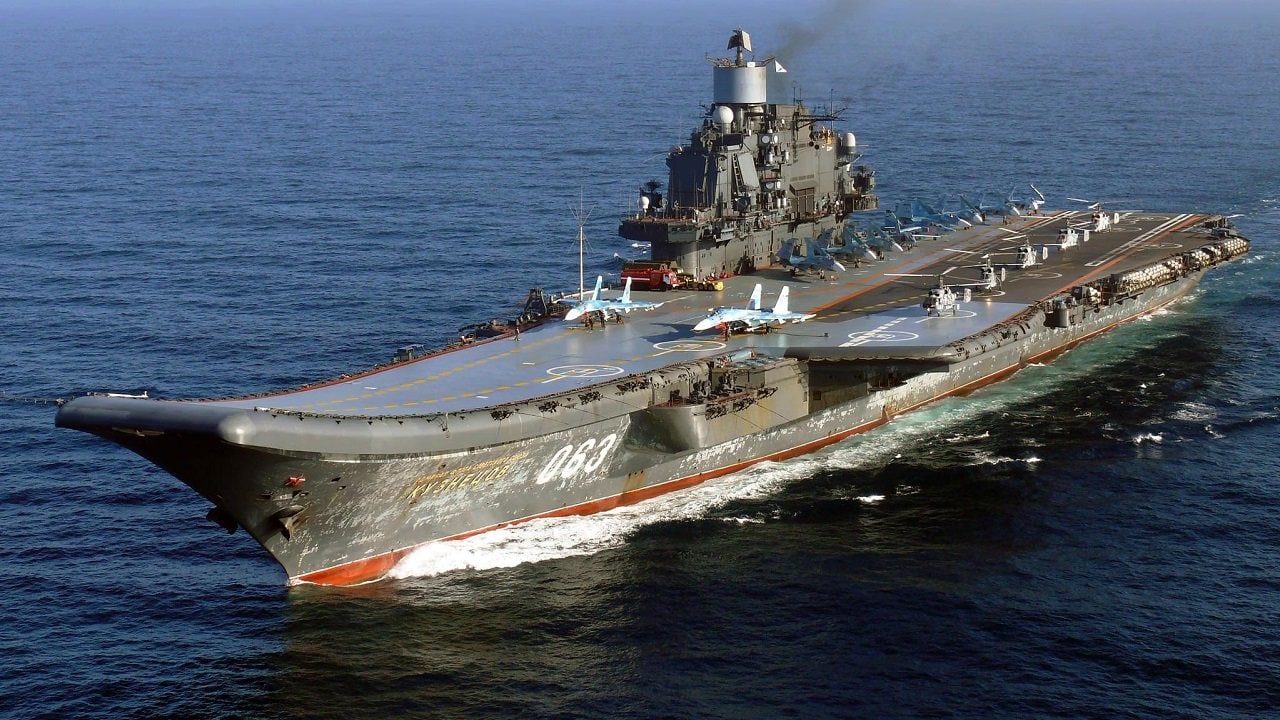Russia’s only aircraft carrier, the Admiral Kuznetsov, is again making news for the wrong reasons. The ‘D’ word has popped up again. I’m talking about another ‘D’ as in delay. Maybe for as long as one year before it is ready to hit the waves. It seems like every year it spends in extended maintenance there is another schedule slippage. In 2021, it was supposed to be ready this year. Then that was pushed back to 2023, Now it won’t be ready until 2024. “Und so weiter” as the Germans say – meaning “etcetera etcetera.”
Admiral Kuznetsov – What’s the Problem Now?
The Kuznetsov has been in maintenance “time-out” since 2018. Russian state run media is vague on the exact ailment this time – something about an unspecified “defect.” Then it will undergo additional tests that could reveal other defects. You see that a pattern is emerging. The propaganda arm said the ship will be set to operate for another 10 to 15 years when it is finally ready.
Born Under a Bad Sign
1945 has chronicled this cursed bucket of bolts extensively. It runs on a stinky, black, tar-like substance called mazut. It’s an old carrier having joined the fleet in 1985. The ski-jump on the topside is out of date – it’s not a flat deck with a modern catapult. The engines were never sufficient. It has frequently broken down and had to be towed by tug-boats. It has only achieved one combat deployment – in the Syrian theater in the Eastern Mediterranean Sea in 2016 and 2017. And that cruise lost two aircraft due to faulty arresting gear.
You Mean There’s Been More Problems?
Things went downhill quickly after that mission. In 2018, a floating crane fell over and killed one worker with four others injured. A year later a welding incident caused a fire that resulted in two people dead with 14 others burned or harmed by smoke inhalation. In 2021, a shipyard director embezzled around $600,000 from the maintenance fund. Don’t forget the oil leak off the coast of Ireland. Now there are sanctions against the United Shipbuilding Corporation that will likely keep the required work from happening on schedule.
Do Something, Anything
At this point, you would think the Russian navy would just give up and start over. Vladimir Putin, stung from his misadventure in Ukraine, is likely sullen and morose about this latest news with his navy. What’s the plan? If Russia, is to be a true blue water navy, it needs an aircraft carrier to project power. The submarine force is one of the best in the world. Russian submarines are test-firing a hypersonic missile called the Tsirkon. There are some modern missile destroyers and frigates, minus the Moskva that was lost during the war in Ukraine. But generally, the Russian navy is in good shape, except for the Kuznetsov.
Admiral Kuznetsov – Could Russia Sell It?
This carrier is a mystery, and it may never sail again. Putin is probably being misled by his defense ministry on how badly the Kuznetsov is struggling. He has heard “one more year,” repeatedly. It’s time he makes an executive decision about the carrier’s future. Perhaps it could be sold to a country like North Korea. Kim Jong Un wouldn’t mind the capability, but he would not relish the headaches and would feel he was given a bum steer from Russia. Would Iran be interested? One could see how the Iranians would want a carrier. They are always looking for the latest edge to bully enemies in the Middle East.
This Admiral Kuznetsov carrier fiasco is an embarrassment for Russia. Staying the course is not reassuring. Selling it is probably a non-starter. Scrapping it is unthinkable. The Admiral Kuznetsov is a money pit with no easy answers.
Now serving as 1945’s Defense and National Security Editor, Brent M. Eastwood, PhD, is the author of Humans, Machines, and Data: Future Trends in Warfare. He is an Emerging Threats expert and former U.S. Army Infantry officer. You can follow him on Twitter @BMEastwood.

